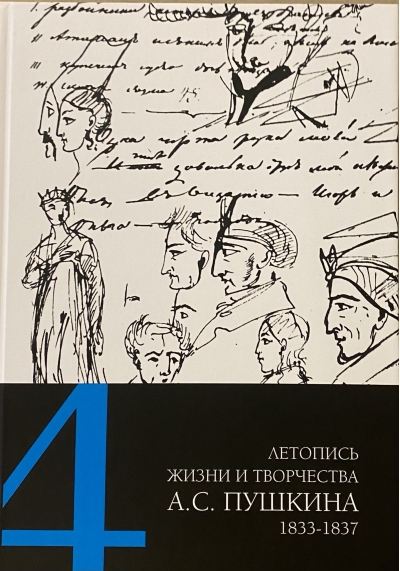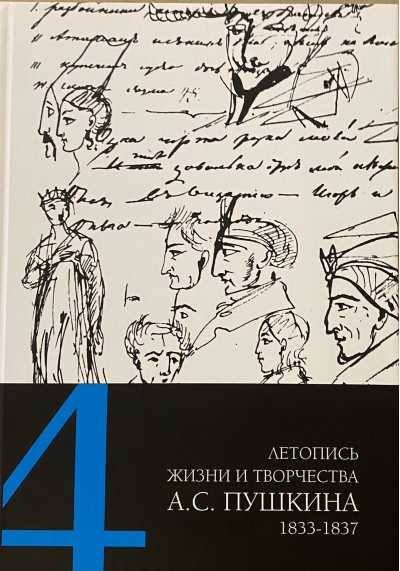Chronicle of the Life and Work of A.S. Pushkin. In 5 volumes. Volume 4. 1833–1837
39.99 €
The only thing available 1
"The Chronicle of the Life and Work of A.S. Pushkin" (compiled by N.A. Tarkhova) belongs to the genre of a reference monographic publication common in Russian literary studies. It is a chronological collection of documents about Pushkin's life, supplied with archival and bibliographic references and detailed comments. Work on the Chronicle involves referring to all lifetime sources, both handwritten and printed, familiarity with the entire corpus of historical and biographical works about the life and work of the writer, as well as a careful selection of materials to eliminate legendary and unreliable information. As a rule, each article in the Chronicle is devoted to a separate event from the life of its character, and one date may include several articles devoted to events of various kinds, both creative and biographical. All chronicle articles are built on a single principle and contain diverse information:
1) Description of an event, be it a creative act or any historical and everyday incident;
2) Reference to Pushkin's work, if this event is mentioned in it;
3) Reference to an autograph, if we are talking about the writer's works, letters or personal documents;
4) Reference to the publication of Pushkin's text in an authoritative edition of the writer;
5) Reference to the first lifetime publication;
6) Bibliographic references to the works of researchers;
7) Chronological references to events related to the described;
8) Historical and literary, historical or everyday commentary on the event.
A wide range of reference material ensures comfort and convenience when working with the book. In addition, the year of the event and Pushkin's current location are indicated in the footer on each page; the place where the event takes place, in which Pushkin does not participate, is indicated in the article.
The book has a large and high-quality reference apparatus, contains five annotated indexes:
1) Bibliographic, it indicates all the sources used and provides their conventional designations;
2) Name index, in which information about people is indicated at the time of their communication with Pushkin;
3) Index of Pushkin's works;
4) Geographical;
5) Index of periodicals in which his works were published during the writer's lifetime, or responses to them were printed.
In addition, there is an Index of conventional abbreviations for the entire text of the Chronicle. All indexes are necessary when working with the Chronicle.
The words of one of the literary scholars that the chronicle of the life of any writer reflects the current state of science about him, fully correspond to the content and apparatus of the book. It takes into account and uses all the results and achievements of Pushkin studies in the last decades of the twentieth century and the new, 21st century. Fundamental works: facsimile published manuscripts of the Workbooks and the Boldino Manuscripts; a new academic 20-volume collected works of Pushkin, the publication of which, like the Pushkin Encyclopedia, is not yet complete; a two-volume set of "Documents for a Biography" and a multi-volume "Pushkin in Criticism", a periodical collection "Pushkin and His Contemporaries. All these publications of recent decades are used in the chronicle, it also takes into account all the publications of newly discovered documents (for example, "The Diary of Dolly Ficquelmont" or the correspondence of the Gekkerns, which clarify and deepen our knowledge of events that would seem to be known, or clarify what happened, giving it a different meaning, compared to the traditional view). Numerous works by literary historians and biographers of the writer, published in scientific collections and monographs, are also taken into account in the Chronicle.
The "Pushkin Chronicle" differs from the previous edition in two important features, adopted for the convenience of working with a multi-volume book and taking into account user feedback. The first is the existence of a reference volume in the edition, which combines all the indexes to individual volumes; the combined apparatus of the book, all its tools are convenient to work with and allow you to avoid many technical difficulties in it (The Reference Volume for the previous edition was made when the Chronicle was already on sale, and published as an experiment five years after the edition was sold out, but it was bought up very willingly due to its convenience, which was immediately appreciated). The second feature is also dictated by considerations of convenience and saving time in work, it consists in the fact that all comments in the book follow directly after the text of the article to which they relate, and are not collected at the end of the volume, as was customary before, which significantly simplifies working with them.
"The Chronicle of Pushkin" is a useful, and for scientific research simply necessary book, it is eagerly awaited by specialists. And many educated readers increasingly prefer the "Chronicle" to author biographies; an objective chronological collection of documents seems to them to be the most objective and reliable work, free from the author's subjectivity.
1) Description of an event, be it a creative act or any historical and everyday incident;
2) Reference to Pushkin's work, if this event is mentioned in it;
3) Reference to an autograph, if we are talking about the writer's works, letters or personal documents;
4) Reference to the publication of Pushkin's text in an authoritative edition of the writer;
5) Reference to the first lifetime publication;
6) Bibliographic references to the works of researchers;
7) Chronological references to events related to the described;
8) Historical and literary, historical or everyday commentary on the event.
A wide range of reference material ensures comfort and convenience when working with the book. In addition, the year of the event and Pushkin's current location are indicated in the footer on each page; the place where the event takes place, in which Pushkin does not participate, is indicated in the article.
The book has a large and high-quality reference apparatus, contains five annotated indexes:
1) Bibliographic, it indicates all the sources used and provides their conventional designations;
2) Name index, in which information about people is indicated at the time of their communication with Pushkin;
3) Index of Pushkin's works;
4) Geographical;
5) Index of periodicals in which his works were published during the writer's lifetime, or responses to them were printed.
In addition, there is an Index of conventional abbreviations for the entire text of the Chronicle. All indexes are necessary when working with the Chronicle.
The words of one of the literary scholars that the chronicle of the life of any writer reflects the current state of science about him, fully correspond to the content and apparatus of the book. It takes into account and uses all the results and achievements of Pushkin studies in the last decades of the twentieth century and the new, 21st century. Fundamental works: facsimile published manuscripts of the Workbooks and the Boldino Manuscripts; a new academic 20-volume collected works of Pushkin, the publication of which, like the Pushkin Encyclopedia, is not yet complete; a two-volume set of "Documents for a Biography" and a multi-volume "Pushkin in Criticism", a periodical collection "Pushkin and His Contemporaries. All these publications of recent decades are used in the chronicle, it also takes into account all the publications of newly discovered documents (for example, "The Diary of Dolly Ficquelmont" or the correspondence of the Gekkerns, which clarify and deepen our knowledge of events that would seem to be known, or clarify what happened, giving it a different meaning, compared to the traditional view). Numerous works by literary historians and biographers of the writer, published in scientific collections and monographs, are also taken into account in the Chronicle.
The "Pushkin Chronicle" differs from the previous edition in two important features, adopted for the convenience of working with a multi-volume book and taking into account user feedback. The first is the existence of a reference volume in the edition, which combines all the indexes to individual volumes; the combined apparatus of the book, all its tools are convenient to work with and allow you to avoid many technical difficulties in it (The Reference Volume for the previous edition was made when the Chronicle was already on sale, and published as an experiment five years after the edition was sold out, but it was bought up very willingly due to its convenience, which was immediately appreciated). The second feature is also dictated by considerations of convenience and saving time in work, it consists in the fact that all comments in the book follow directly after the text of the article to which they relate, and are not collected at the end of the volume, as was customary before, which significantly simplifies working with them.
"The Chronicle of Pushkin" is a useful, and for scientific research simply necessary book, it is eagerly awaited by specialists. And many educated readers increasingly prefer the "Chronicle" to author biographies; an objective chronological collection of documents seems to them to be the most objective and reliable work, free from the author's subjectivity.
See also:
- All books by the publisher











